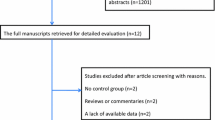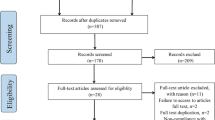Abstract
Objective
Increased oxidative stress has been identified as a pathogenetic mechanism in female infertility. However, the effect of specific antioxidants, such as coenzyme Q10 (CoQ10), on the outcomes after assisted reproductive technologies (ART) has not been clarified. The aim of this study was to systematically review and meta-analyze the best available evidence regarding the effect of CoQ10 supplementation on clinical pregnancy (CPR), live birth (LBR), and miscarriage rates (MR) compared with placebo or no-treatment in women with infertility undergoing ART.
Methods
A comprehensive literature search was conducted in PubMed (MEDLINE), Cochrane, and Scopus, from inception to March 2020. Data were expressed as odds ratio (OR) with 95% confidence intervals (CI). The I2 index was employed for heterogeneity.
Results
Five randomized-controlled trials fulfilled eligibility criteria (449 infertile women; 215 in CoQ10 group and 234 in placebo/no treatment group). Oral supplementation of CoQ10 resulted in an increase of CPR when compared with placebo or no-treatment (28.8% vs. 14.1%, respectively; OR 2.44, 95% CI 1.30–4.59, p = 0.006; I2 32%). This effect remained significant when women with poor ovarian response and polycystic ovarian syndrome were analyzed separately. No difference between groups was observed regarding LBR (OR 1.67, 95% CI 0.66–4.25, p = 0.28; I2 34%) and MR (OR 0.61, 95% CI 0.13–2.81, p = 0.52; I2 0%).
Conclusions
Oral supplementation of CoQ10 may increase CPR when compared with placebo or no-treatment, in women with infertility undergoing ART procedures, without an effect on LBR or MR.





Similar content being viewed by others
Data availability
Not applicable.
Abbreviations
- IVF:
-
In vitro fertilization
- ICSI:
-
Intracytoplasmic sperm injection
- hCG:
-
Human chorionic gonadotropin
- PCOS:
-
Polycystic ovary syndrome
- POR:
-
Poor ovarian response
References
Zegers-Hochschild F, Adamson GD, Dyer S, Racowsky C, de Mouzon J, Sokol R, et al. The International Glossary on Infertility and Fertility Care, 2017. Hum Reprod. 2017;32(9):1786–801. https://doi.org/10.1093/humrep/dex234.
Farquhar C, Marjoribanks J. Assisted reproductive technology: an overview of Cochrane Reviews. Cochrane Database Syst Rev. 2018;8:CD010537. https://doi.org/10.1002/14651858.CD010537.pub5.
Showell MG, Mackenzie-Proctor R, Jordan V, Hart RJ. Antioxidants for female subfertility. Cochrane Database Syst Rev. 2017;7:Cd007807. https://doi.org/10.1002/14651858.CD007807.pub3.
Sasaki H, Hamatani T, Kamijo S, Iwai M, Kobanawa M, Ogawa S, et al. Impact of oxidative stress on age-associated decline in oocyte developmental competence. Front Endocrinol. 2019;10:811. https://doi.org/10.3389/fendo.2019.00811.
Xu Y, Nisenblat V, Lu C, Li R, Qiao J, Zhen X, et al. Pretreatment with coenzyme Q10 improves ovarian response and embryo quality in low-prognosis young women with decreased ovarian reserve: a randomized controlled trial. Reprod Biol Endocrinol. 2018;16(1):29. https://doi.org/10.1186/s12958-018-0343-0.
Banerjee P, Bhattacharya J. Impact of oxidative stress on infertility, with emphasis on infertility management strategies. Glob J Fertil Res. 2019;4(1):10–8. https://doi.org/10.17352/gjfr.000012.
Valko M, Leibfritz D, Moncol J, Cronin MT, Mazur M, Telser J. Free radicals and antioxidants in normal physiological functions and human disease. Int J Biochem Cell Biol. 2007;39(1):44–84. https://doi.org/10.1016/j.biocel.2006.07.001.
Shkolnik K, Tadmor A, Ben-Dor S, Nevo N, Galiani D, Dekel N. Reactive oxygen species are indispensable in ovulation. Proc Natl Acad Sci U S A. 2011;108(4):1462–7. https://doi.org/10.1073/pnas.1017213108.
Fujii J, Iuchi Y, Okada F. Fundamental roles of reactive oxygen species and protective mechanisms in the female reproductive system. Reprod Biol Endocrinol. 2005;3:43. https://doi.org/10.1186/1477-7827-3-43.
Lu J, Wang Z, Cao J, Chen Y, Dong Y. A novel and compact review on the role of oxidative stress in female reproduction. Reprod Biol Endocrinol. 2018;16(1):80. https://doi.org/10.1186/s12958-018-0391-5.
Kurutas EB. The importance of antioxidants which play the role in cellular response against oxidative/nitrosative stress: current state. Nutr J. 2016;15(1):71. https://doi.org/10.1186/s12937-016-0186-5.
Rodick T, Seibels D, Jeganathan R, Huggins K, Ren G, Mathews S. Potential role of coenzyme Q10 in health and disease conditions. Nutr Diet Suppl. 2018;10:1–11. https://doi.org/10.2147/NDS.S112119.
Liberati A, Altman DG, Tetzlaff J, Mulrow C, Gøtzsche PC, Ioannidis JPA, et al. Preferred reporting items for systematic reviews and meta-analyses: the PRISMA statement. BMJ. 2009;339:b2535. https://doi.org/10.1136/bmj.b2535.
Higgins JPT, Altman DG, Gøtzsche PC, Jüni P, Moher D, Oxman AD, et al. The Cochrane Collaboration’s tool for assessing risk of bias in randomised trials. BMJ. 2011;343:d5928. https://doi.org/10.1136/bmj.d5928.
Tufanaru C, Munn Z, Stephenson M, Aromataris E. Fixed or random effects meta-analysis? Common methodological issues in systematic reviews of effectiveness. Int J Evid Based Healthc. 2015;13:196–207. https://doi.org/10.1097/XEB.0000000000000065.
El Refaeey A, Selem A, Badawy A. Combined coenzyme Q10 and clomiphene citrate for ovulation induction in clomiphene-citrate-resistant polycystic ovary syndrome. Reprod BioMed Online. 2014;29(1):119–24. https://doi.org/10.1016/j.rbmo.2014.03.011.
Bentov Y, Hannam T, Jurisicova A, Esfandiari N, Casper RF. Coenzyme Q10 Supplementation and Oocyte Aneuploidy in Women Undergoing IVF-ICSI Treatment. Clin Med Insights Reprod Health. 2014;8:31–6. https://doi.org/10.4137/cmrh.S14681.
Caballero T, Fiameni F, Valcarcel A, Buzzi J. Dietary supplementation with coenzyme Q10 in poor responder patients undergoing IVF-ICSI Treatment. Fertil Steril. 2016;106(3):e58. https://doi.org/10.1016/j.fertnstert.2016.07.177.
Sen SD. Co-enzyme q10-a mitochondrial antioxidant -a new hope for success in infertility in clomiphene-citrate-resistant polycystic ovary syndrome. CENTRAL. 2019;2019(3). https://doi.org/10.1111/1471-0528.2_14571.
Ferraretti AP, La Marca A, Fauser BC, Tarlatzis B, Nargund G, Gianaroli L. ESHRE consensus on the definition of 'poor response' to ovarian stimulation for in vitro fertilization: the Bologna criteria. Hum Reprod. 2011;26(7):1616–24. https://doi.org/10.1093/humrep/der092.
The Rotterdam ESHRE/ASRM-Sponsored PCOS Consensus Workshop Group. Revised 2003 consensus on diagnostic criteria and long-term health risks related to polycystic ovary syndrome. Fertil Steril. 2004;81(1):19–25. https://doi.org/10.1016/j.fertnstert.2003.10.004.
Ben-Meir A, Kim K, McQuaid R, Esfandiari N, Bentov Y, Casper RF, et al. Co-enzyme Q10 supplementation rescues cumulus cells dysfunction in a maternal aging model. Antioxidants. 2019;8(3):58. https://doi.org/10.3390/antiox8030058.
Zhang M, ShiYang X, Zhang Y, Miao Y, Chen Y, Cui Z, et al. Coenzyme Q10 ameliorates the quality of postovulatory aged oocytes by suppressing DNA damage and apoptosis. Free Radic Biol Med. 2019;143:84–94. https://doi.org/10.1016/j.freeradbiomed.2019.08.002.
Ozcan P, Ficicioglu C, Kizilkale O, Yesiladali M, Tok OE, Ozkan F, et al. Can coenzyme Q10 supplementation protect the ovarian reserve against oxidative damage? J Assist Reprod Genet. 2016;33(9):1223–30. https://doi.org/10.1007/s10815-016-0751-z.
Lafuente R, González-Comadrán M, Solà I, López G, Brassesco M, Carreras R, et al. Coenzyme Q10 and male infertility: a meta-analysis. J Assist Reprod Genet. 2013;30(9):1147–56. https://doi.org/10.1007/s10815-013-0047-5.
Agarwal A, Sharma A, Master K, Sharma R, Henkel R. Meta-analysis of double-blind placebo control trials evaluating the role of coenzyme Q10 on semen parameters. Fertil Steril. 2018;110(4):e167–e8. https://doi.org/10.1016/j.fertnstert.2018.07.497.
Smits RM, Mackenzie-Proctor R, Yazdani A, Stankiewicz MT, Jordan V, Showell MG. Antioxidants for male subfertility. Cochrane Database Syst Rev. 2019;(3). https://doi.org/10.1002/14651858.CD007411.pub4.
Agarwal A, Gupta S, Sharma RK. Role of oxidative stress in female reproduction. Reprod Biol Endocrinol. 2005;3:28. https://doi.org/10.1186/1477-7827-3-28.
Wu X, Iguchi T, Itoh N, Okamoto K, Takagi T, Tanaka K, et al. Ascorbic acid transported by sodium-dependent vitamin C transporter 2 stimulates steroidogenesis in human choriocarcinoma cells. Endocrinol. 2008;149(1):73–83. https://doi.org/10.1210/en.2007-0262.
Vural P, Akgul C, Yildirim A, Canbaz M. Antioxidant defence in recurrent abortion. Clin Chim Acta. 2000;295(1-2):169–77. https://doi.org/10.1016/s0009-8981(99)00255-7.
Ledee-Bataille N, Olivennes F, Lefaix JL, Chaouat G, Frydman R, Delanian S. Combined treatment by pentoxifylline and tocopherol for recipient women with a thin endometrium enrolled in an oocyte donation programme. Hum Reprod. 2002;17(5):1249–53. https://doi.org/10.1093/humrep/17.5.1249.
Takasaki A, Tamura H, Taniguchi K, Asada H, Taketani T, Matsuoka A, et al. Luteal blood flow and luteal function. J Ovarian Res. 2009;2:1. https://doi.org/10.1186/1757-2215-2-1.
Thomson RL, Spedding S, Buckley JD. Vitamin D in the aetiology and management of polycystic ovary syndrome. Clin Endocrinol. 2012;77(3):343–50. https://doi.org/10.1111/j.1365-2265.2012.04434.x.
Nestler JE. Inositolphosphoglycans (IPGs) as Mediators of Insulin's Steroidogenic Actions. J Basic Clin Physiol Pharmacol. 2011;9(2-4):197–204. https://doi.org/10.1515/JBCPP.1998.9.2-4.197.
Gaskins AJ, Chiu YH, Williams PL, Ford JB, Toth TL, Hauser R, et al. Association between serum folate and vitamin B-12 and outcomes of assisted reproductive technologies. Am J Clin Nutr. 2015;102(4):943–50. https://doi.org/10.3945/ajcn.115.112185.
AbdulameerYahya A, Abdulridha MK, Al-Rubuyae BJ, Al-Atar HA. The effect of vitamin D and co-enzyme Q10 replacement therapy on hormonal profile and ovulation statusin women with clomiphene citrate resistant polycystic ovary syndrome. J Pharm Sci Res. 2019;11(1):208–15 https://www.researchgate.net/publication/330811147_The_Effect_of_Vitamin_D_and_Co-enzyme_Q10_Replacement_Therapy_on_Hormonal_Profile_and_Ovulation_Statusin_Women_with_Clomiphene_Citrate_Resistant_Polycystic_Ovary_Syndrome.
Pritchard N, Healey M, Sorby KL, Sivapalan S, Osianlis T, Jatkar S, et al. A case control study of melatonin with or without coenzyme Q10 in improving oocyte quality and outcomes in in vitro fertilization. Reprod Biol Insights. 2015;8:1–7. https://doi.org/10.4137/RBI.S27776.
Gat I, Blanco Mejia S, Balakier H, Librach CL, Claessens A, Ryan EA. The use of coenzyme Q10 and DHEA during IUI and IVF cycles in patients with decreased ovarian reserve. Gynecol Endocrinol. 2016;32(7):534–7. https://doi.org/10.3109/09513590.2015.1137095.
Bhagavan HN, Chopra RK. Coenzyme Q10: Absorption, tissue uptake, metabolism and pharmacokinetics. Free Radic Res. 2006;40(5):445–53. https://doi.org/10.1080/10715760600617843.
Miles MV, Horn P, Miles L, Tang P, Steele P, DeGrauw T. Bioequivalence of coenzyme Q10 from over-the-counter supplements. Nutr Res. 2002;22(8):919–29. https://doi.org/10.1016/S0271-5317(02)00402-5.
Jones K, Hughes K, Mischley L, McKenna DJ. Coenzyme Q-10: Efficacy, safety, and use. Altern Ther Health Med. 2002;8(3):42–55 quiz 6, 138. https://search.proquest.com/docview/204823988?accountid=8359.
Langsjoen PH, Langsjoen PH, Folkers K. Long-term efficacy and safety of coenzyme Q10 therapy for idiopathic dilated cardiomyopathy. Am J Cardiol. 1990;65(7):521–3.
Gouveia F, Costa R, Lemos T. Coenzyme Q10 and polycitic ovary syndrome: systematic review. CMI. 2018;3. https://doi.org/10.15761/CMI.1000168.
Funding
This research did not receive any specific grant from funding agencies in the public, commercial, or not-for-profit sectors.
Author information
Authors and Affiliations
Contributions
PF designed the research, searched the literature, extracted and analyzed the data, and wrote the first draft of the paper. PT searched the literature, extracted the data, and was responsible for the statistical analysis. PA and MC reviewed the manuscript and provided critical scientific input. DGG resolved discrepancies regarding the quality of the studies included in the meta-analysis, provided critical scientific input, and had the primary responsibility for the paper’s final content.
Corresponding author
Ethics declarations
Conflict of interest
The authors declare that they have no conflict of interest.
Ethics approval
Not applicable.
Consent to participate
Not applicable.
Consent for publication
Not applicable.
Code availability
Not applicable.
Additional information
Publisher’s note
Springer Nature remains neutral with regard to jurisdictional claims in published maps and institutional affiliations.
Electronic supplementary material
ESM 1
(DOCX 256 kb).
Rights and permissions
About this article
Cite this article
Florou, P., Anagnostis, P., Theocharis, P. et al. Does coenzyme Q10 supplementation improve fertility outcomes in women undergoing assisted reproductive technology procedures? A systematic review and meta-analysis of randomized-controlled trials. J Assist Reprod Genet 37, 2377–2387 (2020). https://doi.org/10.1007/s10815-020-01906-3
Received:
Accepted:
Published:
Issue Date:
DOI: https://doi.org/10.1007/s10815-020-01906-3




